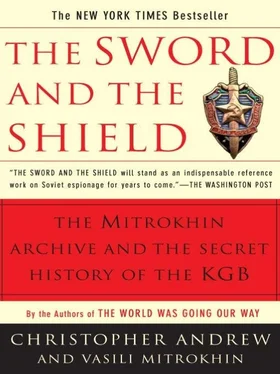The doubts about Moscow felt by some of the NKVD’s British agents after the Nazi-Soviet Pact were more than matched by the Centre’s doubts about its agents. The Center launched an investigation into the possibility that Philby was either a German or a British agent. 97Since Philby had provided the original leads which led to the recruitment of Burgess and Maclean, and ultimately to all the Cambridge recruits, doubts about him reflected on the whole British agent network. The lowest point in the history of NKVD operations in Britain came at the beginning of 1940 when Gorsky, the last member of the London legal residency, was withdrawn to Moscow, leaving not a single NKVD officer active in Britain. A file in the KGB archives records, “The residency was disbanded on the instruction of Beria [head of the NKVD].” 98Beria’s reasons are not recorded, at least in the files examined by Mitrokhin, but chief among them was undoubtedly the recurrent fear that the British agent network was deeply suspect. In February 1940 the Centre issued orders for all contact with Philby to be broken off. 99Contact with Burgess was terminated at about the same time. 100
DURING THE LATER 1930s the hunt for “enemies of the people” replaced intelligence collection as the main priority of NKVD foreign operations. The NKVD’s most active foreign intelligence agency was Serebryansky’s Administration for Special Tasks, whose persecution of INO officers steadily diminished the flow of foreign intelligence and degraded its analysis at the Center. Even the executioners abroad, however, were not immune from the Terror at home. Serebryansky himself became one of the victims of his own witch-hunt. Though he held the Order of Lenin for his many victories over enemies of the people, he was recalled to Moscow in November 1938 and exposed as “a spy of the British and French intelligence services.” An inquiry later concluded that his network contained “a large number of traitors and plain gangster elements.” Though the allegations of espionage for Britain and France were absurd, the charge that Serebryansky had inflated both the size of his illegal network and the scale of its accomplishments in reports to the Centre was probably well founded. 101
Serebryansky’s successor was Pavel Anatolyevich Sudoplatov, who a few months earlier had assassinated the émigré Ukrainian nationalist leader Yevkhen Konovalets with an ingeniously booby-trapped box of chocolates. In March 1939 Sudoplatov became deputy head of foreign intelligence, thus bringing “special tasks” and INO into closer association than ever before. 102He was personally instructed by Stalin that his chief task was to send a task force to Mexico to assassinate Leon Trotsky. The killing of Trotsky, codenamed operation UTKA (“Duck”), had become the chief objective of Stalin’s foreign policy. Even after the outbreak of the Second World War in September 1939, discovering the intentions of Adolf Hitler remained a lower priority than arranging the liquidation of the great heretic. Sudoplatov’s task force was composed of Spanish and Mexican NKVD agents recruited during the Civil War, supervised by his deputy, Leonid Eitingon, whose long experience of “special actions” included the liquidation of “enemies of the people” in Spain. 103
The task force consisted of three groups. The first was an illegal network headed by the Spanish Communist Caridad Mercader del Rio (codenamed MOTHER), who was both recruited and seduced by Eitingon, one of the NKVD’s most celebrated womanizers. 104The most important agent in Caridad Mercader’s group was her son Ramón (codenamed RAYMOND), 105who traveled on a doctored Canadian passport in the name of Frank Jacson (an eccentric NKVD spelling of Jackson). Like Eitingon, Ramón Mercader employed seduction as an operational technique, using his affair with the American Trotskyist Sylvia Ageloff to penetrate Trotsky’s villa near Mexico City. His opportunity came when Ageloff began work as one of Trotsky’s secretaries early in 1940. Each day Mercader drove her to Trotsky’s villa in the morning and returned to collect her after work. Gradually he became a well-known figure with the guards and some of Trotsky’s entourage, who, in March 1940, allowed him into the villa for the first time. Mercader’s role at this stage was still that of penetration agent rather than assassin, with the task of reporting on the villa’s defenses, occupants and guards. 106
The attack on the villa was to be led by a second group of agents drawn from veterans of the Spanish Civil War, headed by the celebrated Mexican Communist painter David Alfaro Siqueiros (codenamed KONE), 107who was animated by an exuberant ideological mix of art, revolution, Stalinism and exhibitionism. Both Mercader and Siqueiros were later to become well known for their involvement in operation UTKA. KGB files, however, also reveal the involvement of a shadowy third group of assassins headed by one of the most remarkable of all Soviet illegals, Iosif Romualdovich Grigulevich (then codenamed MAKS and FELIPE), who had taken a leading role in liquidating Trotskyists during the Spanish Civil War, as well as training saboteurs and arsonists to operate behind Franco’s lines. 108It is a measure of Grigulevich’s skill in assuming false identities that, though born a Lithuanian Jew, 109he was to succeed, a decade later, in passing himself off as a Costa Rican diplomat. 110Early in 1940 he recruited Siqueiros’s former pupil, the painter Antonio Pujol (codenamed JOSE), whom he later described as lacking in initiative but “very loyal, exceptionally reliable and quite bold,” to act as Siqueiros’s second-in-command in the assault on Trotsky’s villa. 111Grigulevich’s other recruits included his future wife and assistant, the Mexican Communist Laura Araujo Aguilar (codenamed LUISA). 112
A key part of the assault plan was the infiltration in April 1940 of a young American agent, Robert Sheldon Harte (codenamed AMUR), posing as a New York Trotskyist, as a volunteer guard in Trotsky’s villa. Harte’s role was to open the main gate when the assault group staged its surprise attack in the middle of the night. 113Though enthusiastic, he was also naive. Grigulevich decided not to brief him on what would happen after he opened the villa gate.
KGB records identify Grigulevich as the real leader of the assault on Trotsky’s villa. 114Grigulevich’s role in the attack was two-fold: to ensure that Siqueiros’s assault group gained entrance to the villa compound, and to try to inject some element of discipline into the attack. Left to his own devices, Siqueiros would have led the assault with all guns blazing but probably have made few attempts to cover his tracks. On the evening of May 23, 1940 Siqueiros and a group of about twenty followers put on a mixture of army and police uniforms and armed themselves with pistols and revolvers. As they did so, according to one of their number, they “laughed and joked as if it were a feast day.” 115Then, with Pujol carrying the only machine-gun, Grigulevich and the assault group set off to assassinate Trotsky. 116
On arriving at the villa in the early hours of May 24, Grigulevich spoke to the American volunteer guard, Harte, who opened the gate. 117The assault group raked the bedrooms with gun fire to such effect that the Mexican police later counted seventy-three bullet holes in Trotsky’s bedroom wall. Remarkably, however, Trotsky and his wife survived by throwing themselves beneath their bed. Though an incendiary bomb was thrown into the bedroom of their small grandson, he too escaped by hiding under his bed. 118Harte was shocked by the attack—particularly, perhaps, by the attempt to kill Trotsky’s grandchild. He angrily told the assault group that, had he known how they would behave, he would never have let them in. To prevent Harte revealing what had happened, he was taken away and shot. 119A few months later, Siqueiros was tracked down and arrested. 120Grigulevich, however, managed to smuggle himself, Pujol and Laura Araujo Aguilar out of the country without his identity being discovered by the Mexican police. From 1942 to 1944 he ran an illegal residency in Argentina which, according to KGB files, planted more than 150 mines in cargoes and ships bound for Germany. 121
Читать дальше











